
Pleco for Android Instruction Manual : Basic Tutorial
This tutorial will take you through the basics of using Pleco and looking up words. Everything described in this tutorial is supported in the free version of Pleco (no paid add-ons required).
The first time you run Pleco, you'll see a prompt appear that looks like this:

Click "Yes" to download the files directly to your phone, or click "No" and go to the referenced web page (pleco.com/androidfiles) if you prefer to install them from your computer over USB (or with an SD card reader). If you click "Yes," the download will begin immediately and Pleco will automatically launch once it's completed:
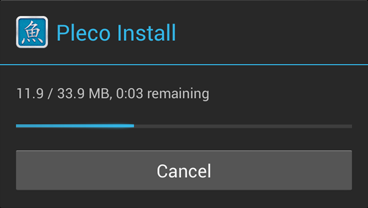
After you finish launching Pleco, you should be presented with a screen that looks like this:
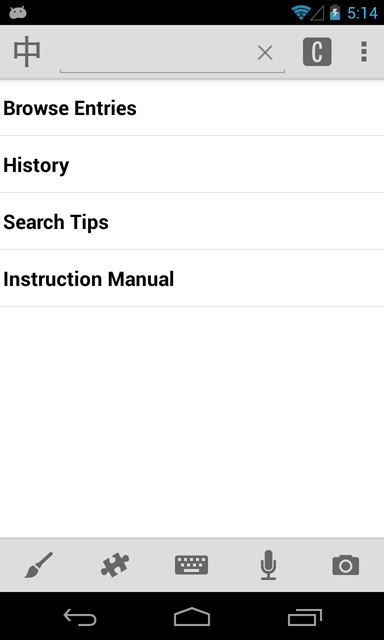
The large text input box at top of this screen is the Search Field - this is where you enter dictionary searches. We'll get back to that in a moment, but for now, look for your Android device's menu button - on most devices, this is an onscreen button at the top right corner of the screen with three vertical dots in it, like this:![]() (also shown in the screenshot above). On some devices, however, it's a hardware button, usually located at the bottom of the screen and very often using some variation on that three-dots theme.
(also shown in the screenshot above). On some devices, however, it's a hardware button, usually located at the bottom of the screen and very often using some variation on that three-dots theme.
Once you've found that button, press it to bring up the menu bar:
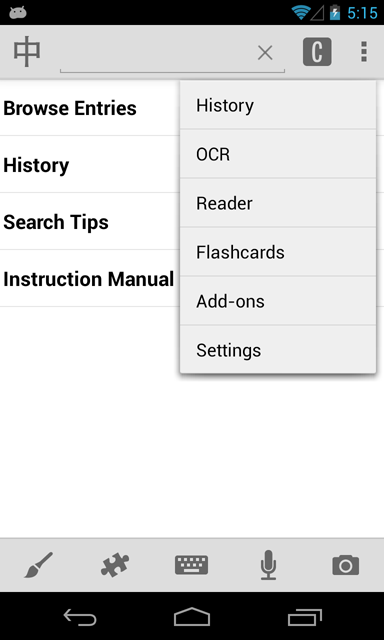
With a harware button, this will appear at the bottom of the screen a bit, and may look a bit different, but will contain the same set of 6 options.
You can use this bar to jump between different sections of Pleco. "History" lets you view a list of recently viewed entries / recently entered search terms, "OCR" brings up our fabulous camera-based character recognizer (paid add-on), "Reader" brings up the clipboard and text file reader, "Flashcards" brings up our flashcard system for creating and testing yourself on word lists, "Add-ons" lets you download add-on modules (some free, some paid), and "Settings" lets you access Pleco's vast array of configuration settings along with letting you manage your purchase registration, consult this instruction manual, and contact Pleco technical support.
OCR / Reader / Flashcards / Add-ons / Settings can be accessed this same way from within any screen in Pleco; you can switch back to the main dictionary from one of them by choosing Dict.
For now, just press the back button or tap anywhere outside of the menu to close it.
The row of buttons below the search bar lets you choose between different ways of inputting text into Pleco - the brush is for handwriting input (paid add-on), the puzzle piece is for radical input (free), the keyboard for keyboard input (obviously free) and the microphone for voice recognition (also free but requires a network connection). If you've downloaded the OCR add-on you'll also see a fifth button with a camera icon that you can use to access that.
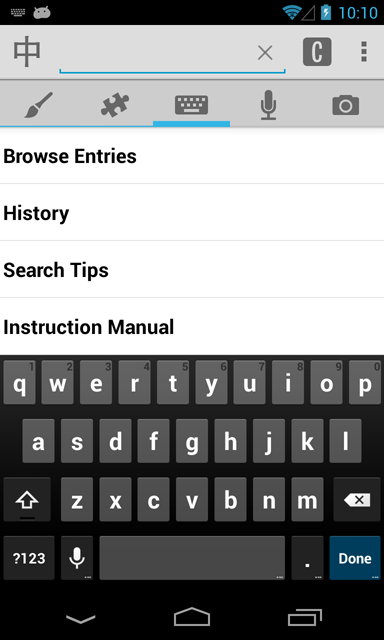
Make sure that the keyboard is selected, then type "nihao" on the keyboard to search for "nihao" in Pinyin:
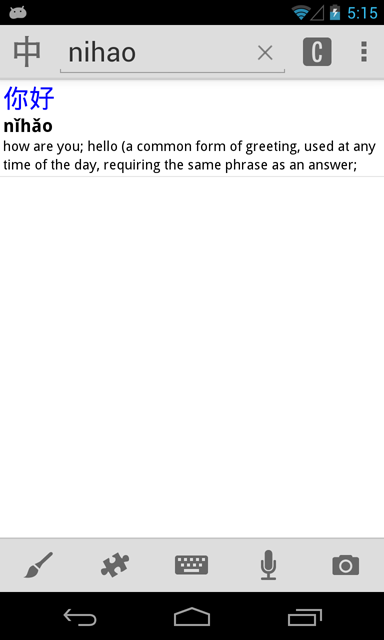
Tap on the first list item (你好) to view its full definition:
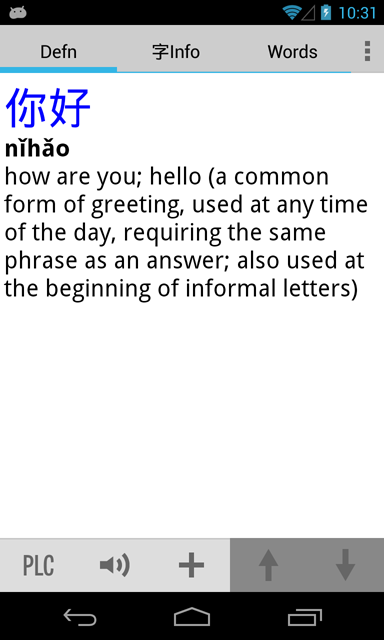
You'll notice that 你 and 好 are each colored blue, both here in the definition screen and in the search results list. Characters in dictionary headwords are colored based on their Mandarin tone; red for first tone (flat), green for second tone (rising), blue for third tone (falling-rising), purple for fourth tone (falling), and gray for the "neutral" fifth tone. You can disable this tone-coloring feature or change the colors it uses in the "Tone Colors" section of the General settings panel.
Tap on your device's back button to return to the main dictionary screen. On most devices, that's the arrow at the bottom left corner of the screen (as in the screenshot above) - on some devices it may be a hardware button below the screen, but will probably have some sort of left-facing arrow icon.
Pleco supports a wide array of add-on dictionary databases and other features, both paid and free, which greatly expand its capabilities. One free add-on adds support for basic audio pronunciation (read syllable-by-syllable); let's download that now. Tap on the menu button again and tap on "Add-ons" to bring up this screen (after a short delay while the software downloads its current add-on catalog):
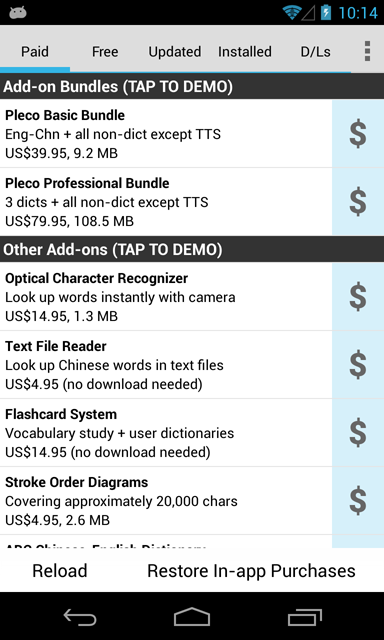
This tab is for paid add-ons; you can tap on an add-on list item to read its description / enable educational discounts. If you downloaded Pleco from Android Market, you can tap on the dollar sign icon next to the item to purchase it immediately. Android Market users will also see a "Restore Purchases" button next to "Reload" at the bottom of the screen - you can use that to reactivate your purchases on a new device.
For now, though, we're interested in free add-ons, so tap on the "Free" tab at the top of the screen to view a list of those:

You should see an item listed here called "Audio pronunciation (male)" - tap on the download arrow icon next to it to immediately download it. A progress bar will appear as the item downloads; you can tap on the item name for more information:

You can also tap on the "D/Ls" tab at the top of the screen to see the status of all pending downloads.
Once that add-on download finishes, you can use it immediately - you don't even need to reopen Pleco first. So just press the back button again to go back to the main dictionary, tap on 你好, and tap on the speaker icon ![]() that appears at the bottom of the screen (or the top of the screen on a tablet).
that appears at the bottom of the screen (or the top of the screen on a tablet).
By default, Pleco shows you results from all installed dictionaries in the same list - duplicate words are combined, so you'll see one copy of each unique word and can tap on it to view its definition in other dictionaries along with the original one. We actually include two free dictionaries with our basic app - "Pleco Basic" and "CC-CEDICT;" the latter has more words, but the former has more detailed definitions with example sentences.
The icon at the top of the screen should look like this: ![]() - that indicates that you're searching all available Chinese dictionaries. Tap twice on that icon to switch to viewing results only from CC-CEDICT:
- that indicates that you're searching all available Chinese dictionaries. Tap twice on that icon to switch to viewing results only from CC-CEDICT:

You'll see that that button has changed to a "CC," indicating that you're now browsing entries in CC-CEDICT.
You can also switch dictionaries in the middle of performing a search. Tap on the Search Field again to open it and begin another search, then type "jintian" on the keyboard:
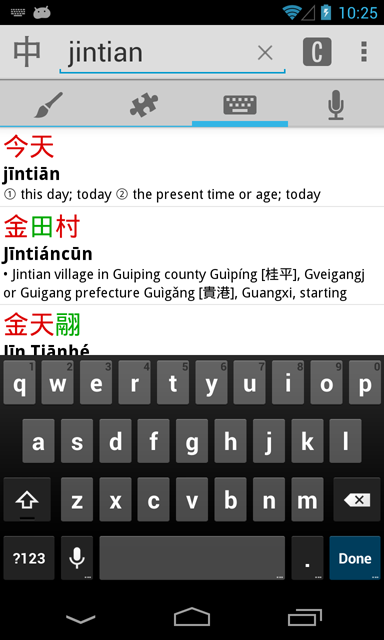
You'll notice that the icon automatically switches back to that original ![]() - if you prefer that it stick with whatever dictionary you were using before, turn off "Reset to first if single dict" in Settings / Dictionary / Search Settings / Search Dictionaries.
- if you prefer that it stick with whatever dictionary you were using before, turn off "Reset to first if single dict" in Settings / Dictionary / Search Settings / Search Dictionaries.
Tap on that same icon to view results from the Pleco Basic dictionary:

If you've installed a lot of dictionaries, you can also tap-hold on the dictionary switch icon to pop up a list of dictionaries, then tap on the dictionary you want to switch to.
This same button also appears at the bottom left corner of the dictionary definition screen; tap on it there to quickly view the definition for the same word in a different dictionary.
See the Advanced Tutorial for information on how to change the dictionary priority order, which will also determine which dictionary's results will show up first when multiple dictionaries include an entry for the same word.
Tap on the first search result to bring up its full definition:
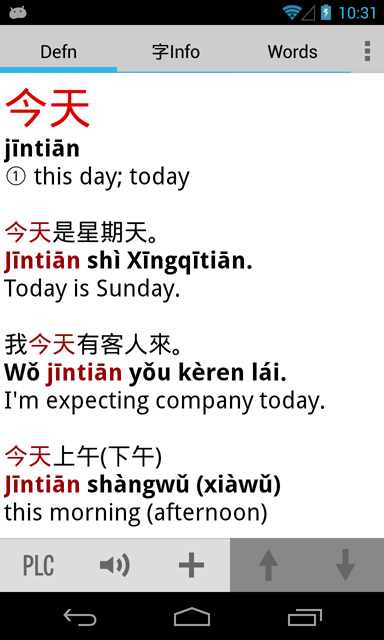
Tap on the PLC icon at the bottom left corner of the screen to view this definition in CC-CEDICT instead:

Tap on the button again to switch back to PLC, then tap on the the character 客 in the second example sentence and the interface will change to look like this:

You can look up the definition for any Chinese word or character you see in a dictionary entry simply by tapping on it. The arrow buttons at the bottom of the screen let you quickly change which word / character you're looking at; the ![]() and
and ![]() buttons move the highlight to the next/previous word or character, while the
buttons move the highlight to the next/previous word or character, while the ![]() and
and ![]() buttons let you shrink or expand the number of characters selected. (we use this same interface in the document reader)
buttons let you shrink or expand the number of characters selected. (we use this same interface in the document reader)
Tap on the shrink button ![]() to select just the first character of "keren":
to select just the first character of "keren":
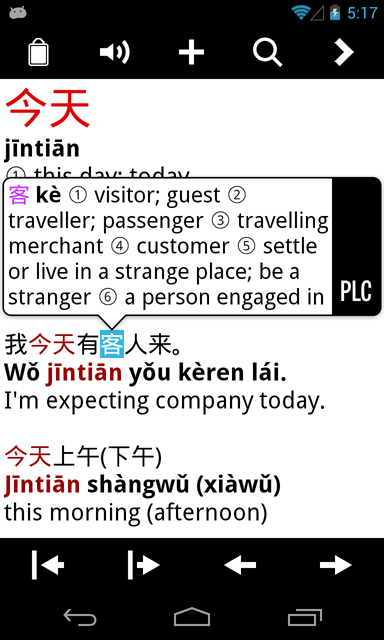
Tap on the expand button ![]() to go back to selecting the full word.
to go back to selecting the full word.
To exit this reader interface, press your device's back button, or just tap your finger anywhere outside of the popup bubble / toolbars.
You may have noticed the "字info" and "Words" tabs at the top of the screen; tap on "字info" to bring up this page:

Here, you can view more information on a character and also bring up a list of compound words starting with or containing it. Tap on any of the items already in the list to remove it or change what information it displays, or add a new item by tapping "Add a new field." You can drag around the handles on the right side of the screen to put the items in a different order.
Since all of this is tied to a single character, we put the headword at the top of the screen so that you can easily select which character in a multi-character word you want to look up; tap on the 天 to see its information instead of that for 今.

Tap on "Words" to view a list of compound words starting with or containing your selected character:
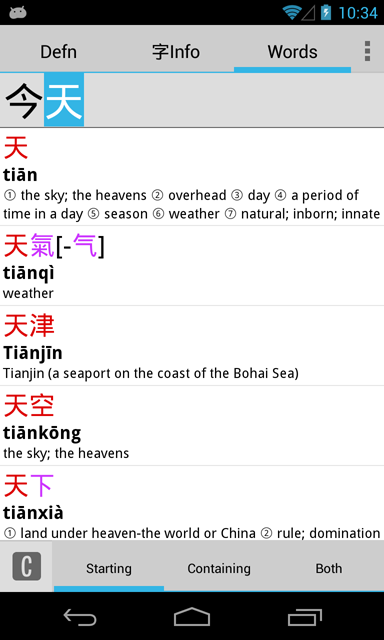
The tabs at the bottom of the screen control which sorts of words you want to search for - "Starting" for words beginning with the selected character, "Containing" for words that contain but don't begin with the selected character (so it's the second / third / fourth character instead), and "Both" for both. You can tap on any of these words to view their definitions in detail.
For now, though, press your device's back button to return to the main search results screen.
Tap on the Search Field once more, then enter the search term "hello":
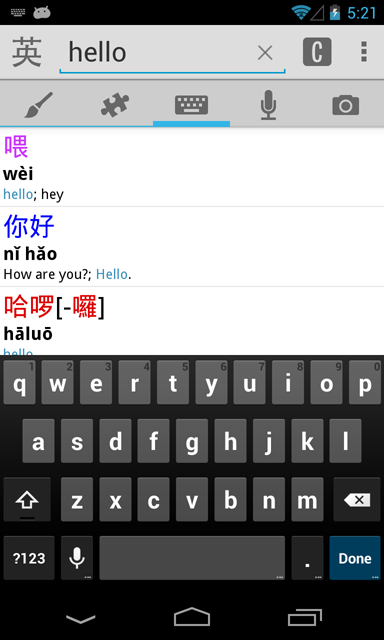
You'll notice that the icon at the top-left corner of the screen has changed from a 中 to a 英, indicating that you're now in English-to-Chinese mode. Since you haven't installed any English-to-Chinese dictionaries yet, Pleco searches the Chinese-to-English dictionaries you've installed for entries containing the word "hello" and highlights them in the search results - this is indicated by the fact that the icon on the right side of the search bar is still a C rather than an E. Basically, the icon on the left determines what you're searching for, while the icon on the right determines where you're searching. If you install an English-Chinese dictionary, you'll get an E instead of a C here by default, but you can still tap on that button to view results from Chinese-English dictionaries.
While Pleco can usually auto-detect whether a word like "hello" is English or Pinyin, some words, like "he," can be either. Tap on the backspace button in the keyboard three times to turn the search term into just "he," then tap on the 英 button to switch back to Chinese-to-English - you'll now see a list of search results for the Pinyin syllable "he."
Clear the Search Field again, then tap on the puzzle piece button (next to the keyboard button) to bring up the radical input screen:

This works just like a radical index in a printed dictionary; tap on the radical for the character you want to look up, scroll to the correct number of non-radical strokes, and tap on the character to enter it in the Search Field. For example, let's look up 谢.
The radical for 谢 is 讠; 讠 has two strokes, so look through the list of radicals after the circled number ② until you find 讠, then tap on it. You'll now see a list of all of the characters containing 讠:
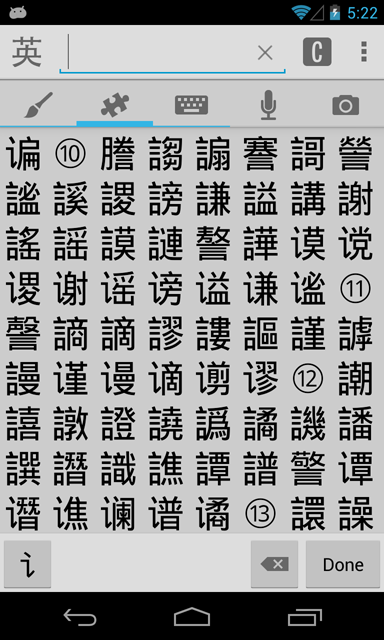
There are 10 strokes in 谢 outside of the 讠, so scroll down to the ⑩ and look for the 谢 after it; tap on 谢 to enter it in the Search Field. Tap on it a second time to enter another 谢, then tap Done to view the results:
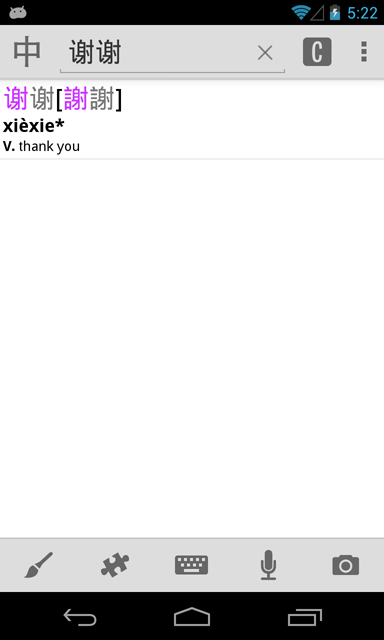
Thanks for reading this tutorial. You can continue on to the Advanced tutorial, which talks about dictionary management, handwriting input, mixed character+pinyin searches, wildcard / full-text searches, stroke order diagrams, audio pronunciation, cross-referencing, and using Pleco in landscape (wide) orientation, skip ahead to the Document Reader or Flashcards tutorials, or dive right into the Dictionary, Reader, Flashcards, Add-ons, or Settings reference manuals.
Return to Table of Contents